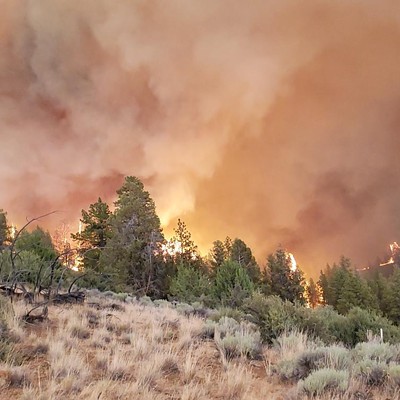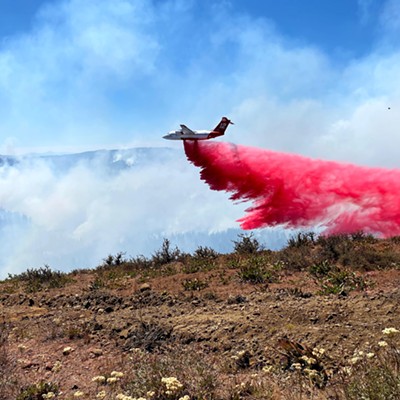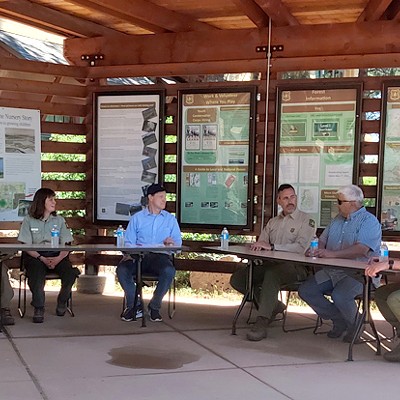Last Monday, when I arrived on the Warm Springs Reservation, it was a whirlwind of confusion. A pillar of smoke billowed in the background.
The Warm Springs Incident Management Team was in the process of transferring firefighting duties to Oregon Interagency Incident Management Team 4 (ORIIMT4)—a well-trained crew made up of federal, state, and municipal fire districts. A few days earlier, a forest fire had started with what is believed to be a human-created spark and quickly expanded to over 10,000 acres. For nearly 100 hours, the Warm Springs Incident Management Team—the local fire fighting squad—had been trying to contain the fire, and not let it roar through the Kah-Nee-Ta Casino. But, it was clear a new level of resources would be needed.
By Tuesday afternoon helicopters with red buckets dangling behind flew along the red canyon walls to refill at the Warm Springs National Fish Hatchery, one of the few sources of easily accessible water on the Reservation.
Fighting wildfires is tricky business. Steep terrain makes for slow and labored access, and communication often proves problematic. Landmarks can be confusing and retreat is difficult. So the transfer of incident command from one group to another is an understandably complicated task, especially so for the team that assumes command. In this case, a management team of 12 was being replaced by a crew of 50-plus who were demanding detailed fire information that hadn't yet been gathered. The Warm Springs personnel, supervised by the Bureau of Indian Affairs, had just been relieved and were cooling off when I caught up with them. The ORIIMT4 team had just been thrown into the flame, but was awaiting intelligence to come back from the fireline, as well as more resources.
Clay Penhollow, a public information officer aiding ORIIMT4 during the transfer of incident command, took me on a drive through smoldering terrain to give me a view of Kah-Nee-Ta. The resort was surrounded by blackened hillsides, but was perfectly unharmed. Penhollow primarily acts as a natural resources planner for the Confederated Tribes, but was off-duty when the fire ignited. Within minutes, it became clear that Penhollow had a solid handle on natural resources and Warm Springs fire history, but knew few details about the Sunnyside Turnoff fire.
It was the same with other dispatch personnel. I asked multiple people within ORIIMT4, including dispatch and public information officers, how many crews were actively on the fire. None could give me a sure answer. Nor could anyone tell me how large the fire was at initial attack. Bill Queen, a public information officer with ORIIMT4, eventually admitted, "You're asking questions that I won't have answers for until later." He seemed just as frustrated as I was. It was a bad scenario. Usually such confusion means there has been a breakdown in communication—a violation of one of the 10 Standard Fire Orders that wildland firefighters live by. In the case of the Sunnyside Turnout fire, communication lines and fire details were later worked out, but in other situations, such as the recent Yarnell Hill fire in Arizona (see page 12), breakdowns allow fires to explode in size. And a fast- growing fire, when combined with lapses in communication and safety protocol, can end badly.
The Incident
Fire has become a regular occurrence on the Warm Springs Indian Reservation. The community is dotted with signs warning of fire danger and alerting drivers to potential arsonists. Here, Smokey the Bear is almost as common as rabbitbrush. And for good reason. While there are forested areas on the reservation that have provided an economic boost via the timber industry, the community itself is largely built into the dusty, hilly rangeland setting on the southeastern portion of its land holdings. As a result, human-caused fires proliferate in this setting where a minor spark can lead to a conflagration.
Of all of the wildfires that were burning throughout the United States last week, the Warm Springs Sunnyside Turnoff fire was the fourth- largest in terms of acreage. As of July 29, the fire has grown to over 51,000 acres only 10 days after it began. There was no lightning—the fire began near a neighborhood. Maybe someone threw a cigarette butt out the window of a car while driving to work Saturday morning. No one is sure how it started, but when the Warm Springs Fire Management Team first responded, the blaze was a manageable three to four acres. By nightfall Saturday, less than 12 hours later, the fire had spread to 2,000 acres. Property protection became the top priority. The Sunnyside and Wolfe Point communities were evacuated, followed soon after by the evacuation of the Kah-Nee-Ta Resort and Spa. Miraculously, with a minimal number of crews and engines, the only structures to succumb to the fire were an abandoned homestead and a corral. By last Saturday, more than 700 men and women were fighting the fire, trying to prevent it from jumping over the Deschutes River, where miles of dried rangeland grasses are tinderbox dry. As resources continued to arrive, pressure was slowly relieved from the shoulders of both fire management and the various crews that had been working the fireline.
All firefighters within the U.S. live by the 10 Standard Fire Orders and 18 Watch Out Situations. These are common-sense standards, much like the best management practices, that if followed will prevent most risks involved with firefighting, including injury and death. Think of them as the OSHA standards for firefighting. When there are deaths, such as the recent tragic loss of 19 firefighters on the Yarnell Hill Fire near Prescott, Ariz., chances are at least one of the 10 Standard Fire Orders and a few of the 18 Watch Out Situations were ignored, a fact that makes such losses even more painful and begs the question: Could better safety have prevented death?
I wanted to find out what proper protocol looked like, so I visited Warm Springs' impromptu fire camp, where portable kitchens, showers and dining areas were being set up. Engine crews and hotshot crews were parked, awaiting the evening briefing where up-to-date progress and game plans would be discussed. Every firefighter I talked to seemed so relaxed it was almost as if they were on vacation. It was the polar opposite of the energy I felt from incident command when I had first arrived.
Firefighters are taught early on that they are not to question "Overhead"—an incident command system term synonymous with supervisors. This value extends from crew member to battalion chief and beyond. In a military-like environment this unwritten policy prevents firefighters from sweating the details. A more relaxed environment follows, one where the firefighters simply wait to be told the essentials, putting full faith into the "Overhead." When I observed this, I wondered to myself whether these men and women would be so relaxed if they had viewed the frantic pace inside the fire management office that I had witnessed earlier in the day.
The Historical Context
Firefighting wasn't always like this. There are new risks involved, and even though safety training and technology have improved exponentially over the past few decades, the world that firefighters are forced to work in has changed.
As wildfire season takes off throughout the West, the recent loss of the 19 Granite Mountain Hotshots, an elite wildland firefighing crew, is on everyone's minds. William Wilson, the assistant fire management officer for Warm Springs, readily reviews the similarities between the Yarnell Hill incident and the wildfires within Warm Springs. It's easy to see the parallels among the desert climates—high temperatures, low relative humidity rates, low fuel moisture and unpredictable winds. Wilson, however, takes it a step further, and cites the similar increases in fire frequency and fire intensity caused by a mixture of long-term fire suppression practices, more popular in past decades, and a change in fuel types as invasive species spread across the American West. Wilson sighs as he lists two more major problems facing firefighters: the increasing number of structures in fire-prone locations and what may be the early effects of climate change. All lead to dangerous situations for fire personnel—situations that wouldn't have existed a few decades ago.
Warm Springs has other odds working against it, too. As a part of the Bureau of Indian Affairs, the Warm Springs fire force gets its funding through the federal government. Wilson laments that with the recession and sequestration in effect, the force has faced a 30 percent budget cut for pre-suppression work, which includes prescribed burning and thinning projects, and a 70 percent budget cut for fuels work, which includes actual wildland firefighting. With such a limited budget affecting the availability of resources on the reservation, Wilson says suppression priorities at initial attack are forced to shift toward structural protection-more specifically, to residents' homes and businesses, leaving the cheatgrass awash in flames.
By Friday of last week the fire had moved into the Mutton Mountains six miles north of the Sunnyside community, where the fire began. Once a great source of ponderosa pine timber, following the reservation's logging boom in the 1970s, Mutton Mountain has been transformed into a tangle of young firs that are burned to the ground almost every 10 years by high-intensity wildfires such as this one. Wilson wants to protect and treat this stand with pre-suppression projects so that one day this beleaguered area can return to providing timber for the mill. However, that budget doesn't exist, and once again, the firs are burning to the ground.
Three of the engine crews had been working on the fireline through the night. They were freshly showered and in clean uniforms. I never would have guessed they had been up all night, if they hadn't mentioned, one after the other, that they were running on only three hours of sleep for the last two days. They had been relieved from duty at noon and would soon be heading back out, but with the sweltering heat reaching triple digits and with their circadian rhythm still in working order, many of the firefighters were not able to sleep between shifts. None of them complained, of course. Instead, this tidbit was mentioned almost with a dash of machismo pride.
Exhaustion is no stranger to firefighters and dedication and adrenaline often overcome sleep deprivation. At least, that's the goal. Exhaustion has long been a hazard in firefighting. It's been acknowledged as the cause of injuries and deaths in the line of work. One of the "Watch Out Situations" for firefighters is "feeling like taking a nap near the fireline." It sounds crazy, but that's what sleep deprivation can do to a person.
Risk is inherent within firefighting, and maybe the true art in the business is managing and minimizing those risks. The transfer of incident command during the Sunnyside Turnout fire required unavoidable risks to be taken, and with skill, luck, and grace on their sides, no one was injured during that chaotic period of management. By Tuesday, intelligence from the fireline had been gathered and better lines of communication were intact. The firefighters were no longer sleep-deprived. Kah-Nee-Ta Resort and Spa opened its doors to the crews, accommodating three to four firefighters per air-conditioned room. A week later containment had reached 90 percent, and the incident was wrapping up. The incident command will once again be transferred to the Warm Springs Incident Management Team.
After the incident command transfer was complete, I noted to Bill Queen that he looked much calmer than he had the day before.
"I have more help. That's why," he answered.
While driving through more burned desert with Clay Penhollow, I asked if there would be a need for habitat restoration after the fire. He responded with a final taste of acceptance.
"Don't worry. This will all be green again come next spring."

























